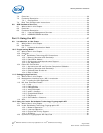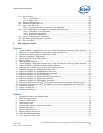
Security Software—Silicon Overview
Intel
®
EP80579 Software for Security Applications on Intel
®
QuickAssist Technology
PG August 2009
12 Order Number: 320183-004US
2.0 Silicon Overview
2.1 What’s New in this Chapter
No updates in this release.
2.2 High Level Overview
The Intel
®
EP80579 Integrated Processor is a System On a Chip (SOC), integrating the
Intel
®
Architecture core processor, the Integrated Memory Controller Hub (IMCH) and
the Integrated I/O Controller Hub (IICH) all on the same die. In addition, it has
integrated Intel
®
QuickAssist Technology, which provides acceleration of cryptographic
and packet processing. It also includes three gigabit Ethernet MACs, TDM interfaces,
and PCI Express. See Figure 1 for details.
• As an SOC, the EP80579 integrates the processor and chipset as follows:
— The IA-32 core is based on the Intel
®
Pentium
®
M processor, and runs at 600-
1200MHz, with a 256 Kilobyte 2-way level 2 (L2) cache.
— The IMCH provides the main path to memory for the IA core and all peripherals
that perform coherent I/O (for example, the PCI express, the IICH, as well as
transactions from the Acceleration and I/O Complex to coherent memory).
— The IICH provides a set of PC platform-compatible I/O devices that include two
SATA 1.0/2.0, two USB 1.1/2.0 host controller supporting two USB ports, and
two serial 16550 compatible UART interfaces.
•The Intel
®
QuickAssist Technology components, housed in the Acceleration and I/O
Complex (AIOC), are as follows:
— The Security Services Unit (SSU) provides acceleration of cryptographic
processing for most common symmetric cryptography (cipher algorithms such
as AES, 3DES, DES, (A)RC4, and messages digest/hash functions such as MD5,
SHA-1, SHA-2, HMAC, etc.); asymmetric cryptography (modular
exponentiation to support public key encryption such as RSA, Diffie-Hellman,
DSA); and true random number generation.
— The Acceleration Services Unit (ASU) includes packet processing acceleration
engines.
• Other components within the AIOC include:
— Three Gigabit Ethernet (GbE) media access controllers (MACs).
— Three High Speed Serial (HSS) interfaces that support up to 12 T1/E1 TDM
interfaces. These interfaces are driven by a Programmable I/O Unit (PIU). The
PIU is not part of the ASU. In Figure 1 on page 13, the PIU is shown as the TDM
Interface block.
— Although not shown explicitly in Figure 1, the AIOC also contains logic to allow
agents to access on-chip SRAM and external DRAM. Based on registers which
can be configured in the BIOS, this logic routes requests to external DRAM
either directly to the memory controller (to access non-coherent DRAM, or
NCDRAM); or through the IMCH for coherency with the IA processor’s L2 cache
(to access Coherent DRAM, or CDRAM). There is also a ring controller, which


















